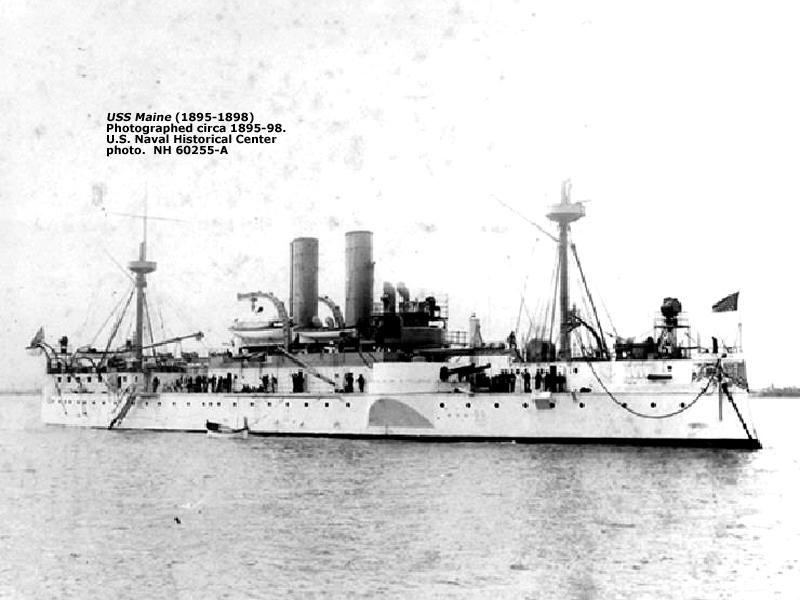In the New York Navy Yard, on October 17, 1888, many American ship builders began building a 6,682 ton battleship soon to be named the USS Maine. This second-class battleship sported four 10 inch and six 6 inch cannons, and 15 pound guns with four 14 inch torpedo tubes when she was launched from the navy yard a year later in November 1889. She was commissioned on September 17, 1895, her was Captain Arent S. Crowninshield, and she crewed 350 men; a few months after her commissioning, she was on her way to her first and final voyage, which was a peace keeping mission to Cuba.1

In January of 1898, the USS Maine steamed from the Florida Keys to Havana Cuba. A Cuban fight for independence from Spain was underway, and with American citizens in Cuba caught in the cross-fire, the presence of an American battleship there would demonstrate US concerns to Spain about those American citizens. The ship was there in what the United Stated called a “friendly act,” though there wasn’t many friendly feeling from the Spanish authorities toward the battleship being in their harbor. No actions against the ship were taken. But at 9:40 P.M. on 15 February, that all changed. Two explosions rocked the ship as it threw pieces of the Maine two-hundred feet in the air as it illuminated the whole harbor. The first explosion was a small dull roar that was followed by a much more powerful second explosion. The explosion was larger due to the forward magazines going off in the fire. The forward half of the ship was reduced to a mass of twisted steel; the aft section slowly sank, leaving two officers and 258 members of the crew dead in the aftermath of the destruction.2

Upon hearing what happened to the USS Maine, both the Spanish and American Governments sent their own investigators to the wreck to determine what happened to the ship. Both investigators came up with completely different conclusions as to the cause of the explosions. The Spanish said that the cause was an internal explosion in the coal bunker, while the American investigator said it was an external explosion that set off the forward magazine after the first explosion. While the investigators were working on the causes, the remaining survivors were rushed to hospitals on a ward steamer and a Spanish cruiser. Eight of those survivors subsequently died. Once news of the Maine’s explosion and the deaths of American sailors reached the States, many Americans believed that the explosion was due an external explosion caused by a shady individual, and they demanded an armed intervention against the Spanish. Though this wasn’t the cause of the Spanish-American War, it was certainly a catalyst for starting it.3

The wreck of the Maine stayed in Havana’s harbor for years, until 1911, when the American Government sent a group of Army engineers to raise the wreck. There they found that the aft section was the only intact part of the ship, so they raised it and floated it out to sea. Then, on the 16th of March, 1912, the Maine was given her minute gun salute as she sank with her flag flowing proudly one last time. Remains of the crew found with her were subsequently laid to rest as well in Arlington cemetery. Before she was sunk, officials performed one last set of investigations. They found evidence that pointed to a faulty boiler as the possible cause of the explosion, but they still lacked conclusive evidence to support the theory, so the cause of the explosion is still undetermined and we may never know for sure what caused the Maine to explode.4
- The Dictionary of American Naval Fighting Ships, 2009, s.v. “USS Maine,” by Naval Historic Center. ↵
- Dictionary of American History, 2003, s.v. “Maine, Sinking of the Maine.” ↵
- The Dictionary of American Naval Fighting Ships, 2009, s.v. “USS Maine,” by Naval Historic Center. ↵
- Dictionary of American History, 2003, s.v. “Sinking of The Maine,” by Walter B. Norris. ↵



41 comments
Seth Roen
From what I understand, the USS Maine was a strange ship, to say the least, outdated by the time she was commissioned and lightly armed and armored to be a proper battleship and too heavy to be an armored cruiser. And yet, she was one of the most powerful ships in the US Navy at the time and started a war when she exploded by an accidental fire.
Chelsea Alvarez
I had never heard of the events that occurred with the USS Maine and I attribute that to what the news feeds to the public. I really enjoyed reading this article, because it shows just how influential the media is on society. The pictures utilized throughout this article makes it all the more interesting. I love mysteries such as these, because it is perplexing to see how great ships such as these can sink without anyone really knowing what really happened.
Michael Leary
Very interesting article, I have learned and read about the sinking of the USS Maine before and how it was a cause of the Spanish-American War. It was very interesting how the Americans and Spanish had different causes of the explosion of the USS Maine, both might have been a bit biased. It is also interesting how the war really propelled Roosevelt from Assistant Secretary of the navy to leader of the Rough Riders, eventually to President.
Alexandra Rodriguez
While the sinking of the USS Maine was ultimately unidentifiable and remains to be a mystery, what I found most interesting was the way the media had contorted and used the ship’s sinking as a way to manipulate their own political agendas. The article was very informative and straight to the point, with just enough information for the readers to be able to recognize the media’s use of the situation, as well as the diverse reasons that countries end up with conflicts and in wars.
Honoka Sasahara
This article is summarized well and easy to understand what had been going on. I felt that it is so difficult to solve problems between different countries with agreements of their each conclusion. It needs as a lot of time and considerations still now as before. This case is also the result of complication of each country’s different aim or intention.
Daniel Linstead
This article was a good read. It was really able to show how powerful the media is at conveying the truth. I am truly puzzled at how a ship of it’s importance was sunk but no one knows the truth behind it. It is amazing how things can be hidden from the truth but yet still be in history. This was a very good article and I learn’t things I never knew before.
Miguel Rivera
In today’s media, sometimes the headlines and the news only show a certain amount of information and likes to keep most of it biased. I think that this is one time when a lot of the newspapers were printing hearsay on what really happened to the USS MAINE. I recently served in the Navy and a lot of what we spoke about on the daily basis was the rumors we would hear either by other Sailors or on the Navy Times. So I can imagine how it went when the incident happened, and I believe that it is one of the most unfortunate events in the history of our Navy. The mystery though will never die though, and it will keep many people fascinated for decades to come.
Christopher Hohman
Nice article really liked the pictures too. the sinking of the USS Maine i think demonstrates just how powerful the press can be in inciting public outcry. We are not sure why the Maine sank, but I believe that many Americans were looking to pick a fight with the Spanish. Due to the fact that the press really riled up the public, it made war with Spain practically inevitable. I did not know that the aft section of the Maine was raised and “buried” with proper honors that is actually a really touching way to honor the ship and those who died.
Thomas Fraire
I observed this to be extremely fascinating. I do surmise that it was Spain that sunk the USS Maine yet I figure we will never know. I extremely enjoyed the part how they took the remaining parts of the general population that passed on the ship and let their spirits rest when they were at long last covered. I likewise truly delighted by they way they gave the ship one final salute as they let her sink to the base, general, I truly appreciated this article.
Timothy ODekirk
I was unaware of the USS Maine before reading this article. However, after reading this article, I have a more clear understanding of the USS Maine and the sinking of it as well. I also found it interesting how the whole sinking was unknown and it is still a mystery on how it truly sank. In addition, I was intrigued by how it took so long for the wreckage to actually be lifted by the U.S. army. This was a successful article and I know more about the sinking of the USS Maine.